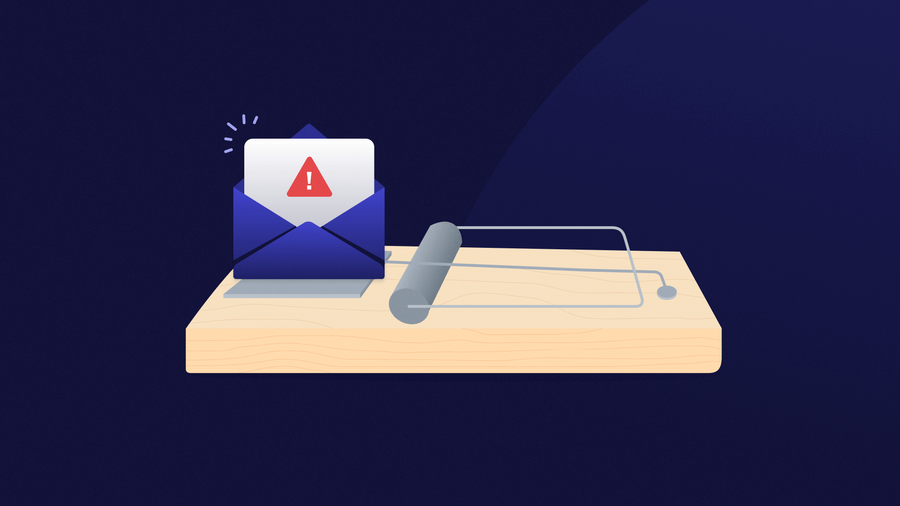If your email marketing efforts are to be impactful, your campaigns must successfully land in your subscribers’ inboxes. This is known as email deliverability, and without it, it doesn’t matter how compelling your email copy is or how dazzling your email design may be. Your emails must be easily visible to users and remain in order with all current email compliance laws.
The greatest risk to your email deliverability? Being mistakenly labeled as email spam by users’ internet service providers (ISPs) because you sent an email to a spam trap.
What is an Email Spam Trap?
Email spam traps are email addresses specifically created and monitored by internet service providers and third-party blocklists to identify and catch spammers. These third-party organizations may include blocklists like SURBL, Spamhaus, Barracuda, or SpamCop. Spam trap email addresses are not used for any legitimate communication and are instead strategically placed to detect unsolicited and potentially malicious emails.
There are three types of spam traps:
- Pristine Spam Traps: These are email addresses that were never used for legitimate purposes and were created specifically as traps. If an email marketer sends messages to these addresses, it suggests poor list acquisition or maintenance practices.
- Recycled Spam Traps: These are email addresses that were once valid and used by real individuals but have been abandoned and repurposed as traps by ISPs or email security companies. Marketers who continue to send emails to addresses that have become inactive may inadvertently hit recycled spam traps.
- Typo Spam Traps: Email addresses set up with common typos, such as "gnail.com," "tahoo.com," "gmail.con," "outlooj.com," etc.
Where do Email Spam Traps Come From?
It’s much easier than you’d think to clog an otherwise clean email list with spam trap emails. Avoiding spam traps means understanding the consequences of poor email practices.
Below are some practices that can cause your emails to be marked as spam:
- Failing to implement a double or confirmed opt-in to ensure active engagement
- Buying email lists from third-party sources containing outdated email addresses
- Using automated data scraping tools to collect email addresses en masse
- Neglecting regular cleaning and updating of email lists
- Continuing to send emails to subscribers who have become inactive
- Using old or legacy data without validating the status of email addresses
- Obtaining leads from sources with a history of questionable practices
- Falling victim to engagement farms, where fake engagement is artificially created to trap marketers who continue to send emails to unresponsive addresses
You should avoid these email marketing practices like the email compliance plague. Many of these tactics can result in consequences that will make spam traps the least of your worries, including subscriber loss, damaged brand reputation, and potential legal penalties.
Read up on more email compliance to keep your sender reputation intact.
What Happens When You Send to a Spam Trap?
From the perspective of an email marketer, spam traps pose a significant threat to email deliverability. If an email marketer sends messages to these traps, it signals to ISPs that they may be engaging in spammy practices or using outdated and poorly maintained email lists. As a result, the sender's reputation can be negatively affected, leading to emails being filtered into recipients' spam folders or, in severe cases, being blocked entirely.
How do You Identify and Avoid Spam Traps?
With all these rogue email addresses floating around the internet, how are you supposed to know how to avoid spam traps and preserve the integrity of your email list?
Use Permission-Based Lists
Build your email lists through permission-based marketing methods. Obtain explicit consent from subscribers to receive your emails, and avoid purchasing or using lists without proper authorization.
This approach helps avoid spam traps by ensuring that the email addresses on your list are willingly provided by recipients who have expressed a genuine interest in receiving communications from your brand. Explicit consent reduces the risk of sending emails to inactive or abandoned addresses that could potentially be spam traps.
Consider adding a confirmed opt-in process, also known as double opt-in, to your permission process. This requires subscribers to confirm their subscription by clicking a verification link in a confirmation email and helps ensure that only valid and engaged subscribers are added to your list.
Learn how to get started with setting up a double opt-in process for email to strengthen your verification process.
Monitor Engagement Metrics
Keeping a finger on the pulse of your email subscriber list is one of the easiest ways to avoid spam traps, and in the process, maintain strong campaign performance.
Tracking key email engagement metrics such as open rates, click-through rates, and overall subscriber activity ensures that the emails on your subscriber list are active and not abandoned email addresses which run the risk of becoming recycled spam traps. Best email hygiene practices dictate that you should continuously monitor and remove emails that have been unresponsive for long periods of time to ensure that each and every recipient is legitimate.
Spam traps don't necessarily bounce back as invalid, but don't necessarily engage with your email messages either. If a recipient has received multiple emails without clicking or even opening the email, then it might be a good idea to remove them from your lists.
Similarly to a confirmed opt-in email, you can also send them a pulse check email that they are required to interact with or they will automatically get unsubscribed from your sending lists.
The best way to improve the overall health of your email engagement rates is through email segmentation. Using a mobile-friendly segmentation tool, segment your email list based on engagement levels, identifying and separating inactive subscribers from your active audience. This allows you to tailor your communication strategies and re-engage with inactive segments separately. By executing focused marketing efforts aimed at re-engaging inactive subscribers, you will bring many of these dormant users back to the table and further separate truly dormant email subscribers from your list. Think of this segmentation process as an extra layer of “straining out” genuine spam trap threats from subscribers who may just need a little tap on the shoulder to re-engage.
Start this process by reviewing our email segmentation best practices.
Regularly Clean and Update Lists
To the above point, be proactive about regularly maintaining your email list and removing inactive or bounced email addresses. Keep your list up to date (at the very least on a quarterly basis) by promptly processing email unsubscribe requests and monitoring delivery failures.
This not only minimizes the likelihood of sending emails to addresses that may have turned into spam traps over time but also improves the quality of your recipient base. By fostering a positive sender reputation, ISPs are more likely to prioritize delivering emails from your brand because you have a proven track record.
Pay special attention to bounce rates and categorize bounces as "hard" (permanent) or "soft" (temporary). Make sure you’re regularly removing email addresses that result in hard bounces from your list!
Learn more about why emails bounce to get an instant leg up in your email deliverability rates.
What is an Example of a Spam Trap Email?
Identifying specific patterns or conventions of spam trap email addresses can be challenging, as anti-spam organizations typically keep these details confidential to prevent manipulation by spammers. However, here are some general characteristics and patterns that might make email spam traps distinguishable from normal email addresses.
Spam traps may consist of combinations of letters, numbers, or symbols that appear completely random or unlikely for a genuine email address. Some spam traps may use generic role-based names, as we mentioned above. These may appear as emails similar to info@example.com, support@example.com, or sales@example.com.
It's important to note that these characteristics are generalizations and spam traps can be designed to mimic real email addresses. Additionally, legitimate email addresses can share some of these characteristics. To minimize the risk of hitting spam traps, email marketers should focus on the proactive measures we mentioned in this article for the best results.
Engagement-First Email Marketing
OneSignal is a powerful engagement platform designed to help you manage your user communication across email, mobile push, in-app messages, SMS, and iOS Live Activities. we know exactly how important deliverability is in the crowded space of mobile marketing. Our email solution leverages best-in-class email service providers and gives you an affordable email composer tailor-made to support your omnichannel campaigns.
When you’re ready, we encourage you to give it a try. We’ve made it easy… your first 5,000 email sends are on us!
Create a Free OneSignal Account



